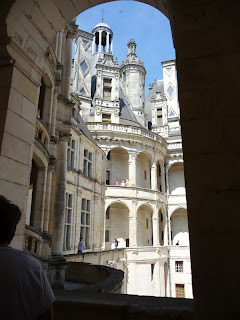Hence, last year my mom and I went there after our visit to Mer, as it was on the way to Amboise where we have stayed over for a few nights. And once again I was impressed by the architecture. It is for sure a castle that you'll have to visit should you consider a visit to the Loire.
It is difficult to fit the castle in on a photo, it is covering such a vast area. Construction started in 1519 at the order of king François I. (What was fascinating to me was that the first restoration work to the castle took place while the Dutch were establishing the Cape!) This is one of the most famous kings in France's history and you will definitely hear of him during a visit to France. On his demand Léonard de Vinci came with him in 1515 from Italy to live in Amboise, close to the royal castle (you can visit his house in Amboise - fascinating!). The staircase in Chambord is said to be designed by de Vinci. The design is peculiar, it is actually two staircases intertwined. So somebody can go up on one, while somebody comes down on the other! Over time the castle was slightly changed by additions by kings after François I.
Above: the bottom of the staircases (you can see one...)
Below: the roof at the top of the staircases
The castle was constructed in a marsh in the heart of the biggest enclosed forest in Europe (50 km2 fenced in by a 32 km wall), resulting in a cold wet area, with mosquitoes in summertime. The king only stayed there for a short duration (There were various castles, and in those days, the king continued to travel through the country to ensure the support of the people. His staff travelled with him and the furniture that would be installed before his arrival, and removed again after his departure. The idea that such an enormous castle was built to be occupied for such a short period of time is mind blowing.) The silhouette you will recognise whenever you see it, knowing which castle it is. It is said that François I wanted the castle to resemble the skyline of Constantinople. Whether that is the case, I cannot confirm. The castle comprises of 77 staircases, 282 chimneys, 800 sculptured tops, 426 rooms and a façade of 156 m, thus being one of the highlights of Renaissance architecture.
Above & below: the castles were decorated in those days with the emblem of the king that ordered the construction. The salamander, sign of François I, as well as a F, you'll see in all the castles which he had a hand in.
We were fortunate to rest our feet in the small cathedral with its wonderful acoustics while listening to a choir from Eastern Europe:
You can go on the canal around the castle or in a horse carriage through the forest. I didn't have the time during the two occasions, as it is such a huge castle and there are others in the Loire to be visited too...
The castle from another angle (when you approach it from the ticket office...)












Glad you've enjoyed it. France has many lovely places but as you say, many times too many tourists...
ReplyDelete